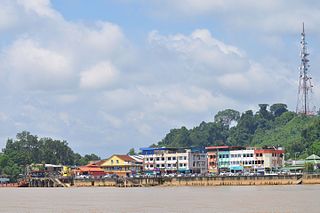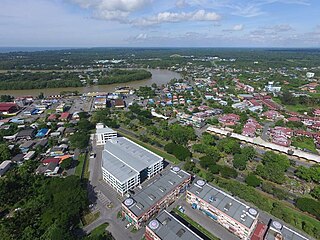
Sibu is a landlocked city located in the central region of Sarawak, Malaysia. It serves as the capital of Sibu District within Sibu Division and is situated on the island of Borneo. Covering an area of 129.5 square kilometres (50.0 sq mi), the city is positioned at the confluence of the Rajang and Igan Rivers, approximately 60 kilometres from the South China Sea and 191.5 kilometres (119 mi) north-east of the state capital, Kuching.

Sarikei is a town, and the capital of Sarikei District in Sarikei Division, Sarawak, Malaysia. It is located on the Rajang River, near where the river empties into the South China Sea. The district population was 56,798.

The Rajang River is a river in Sarawak, northwest Borneo, Malaysia. The river originates in the Iran Mountains, flows through Kapit, and then towards the South China Sea. At approximately 565 km long (351 mi), the river is the seventh-longest in Borneo and the longest in Malaysia.

Tatau is a town, and the capital of the Tatau District in Bintulu Division, Sarawak, Malaysia. The district's reported total population for Tatau was 30,383. Tatau became a district in 1987. Before that it was a Sub District under Bintulu District. The main spoken languages are Iban, Kenyah, Beketan and Punan.

Kanowit is a town and the capital of Kanowit District, Sibu Division, Sarawak, Malaysia, comprising 2,253.5 square kilometres. As of 2010, Kanowit's population is 28,985. It is built on the mouth of Kanowit River at the bank of Rajang River, approximately 174 kilometers from the coast of South China Sea. It takes 45 minutes to reach the town by land transport and an hour by boat from Sibu. The main ethnic groups are Iban, Chinese, Malay, and Melanau.

Mukah Division is one of the twelve administrative divisions in Sarawak, Malaysia. It was established on 1 March 2002 and it has a total area of 6,997.61 square kilometres.

Dalat is the administrative town of the Dalat district in Mukah Division, Sarawak, Malaysia. It is situated by the Oya river.
Melanau or A-Likou is an ethnic group indigenous to Sarawak, Malaysia. They are among the earliest settlers of Sarawak. They speak in the Melanau language, which is a part of the North Bornean branch of Malayo-Polynesian languages.

Bintulu is a coastal town on the island of Borneo in the central region of Sarawak, Malaysia. Bintulu is located 610 kilometres northeast of Kuching, 216 kilometres northeast of Sibu, and 200 kilometres southwest of Miri. With a population of 114,058 as of 2010, Bintulu is the capital of the Bintulu District of the Bintulu Division of Sarawak, Malaysia.
Hornbill Skyways Sdn Bhd is a regional aircraft charter service operating in towns and rural areas in Sarawak. The company slogan is "Wings to your Destination".
MASwings Sdn Bhd is a regional airline operating the Rural Air Services (RAS) in Borneo Malaysia. MASwings is the successors of FlyAsianXpress which operates RAS flight from 2006-2007 and FlyAsianXpress is the successors of RAS flights by Malaysia Airlines from 1965-2006, prior to that Borneo Airways which was the first airlines who operate RAS route from 1953-1965 during British Borneo colonization period.

The Sarawak Corridor of Renewable Energy ("SCORE") is an economic region and development corridor covering central Sarawak, a Malaysian State on the island of Borneo. SCORE was launched in 2008. It is one of the five regional development corridors launched throughout Malaysia during the Abdullah Badawi administration. SCORE is managed by the Regional Corridors Development Authority ("RECODA"), a state government agency created through an Ordinance of the State Legislative Assembly.

Selangau, Sarawak, is a small town located by the Pan Borneo Highway. It is also located by Batang Mukah, a river which flows to the South China Sea. It is located approximately 74 km (46 mi) from Sibu city, 84 km (52 mi) from Mukah town and 134 km (83 mi) from Bintulu town. Selangau town is the administrative centre for the Selangau District.

The Lanang Bridge, Sarawak State Route Q326, is a 1.2-km toll bridge in Sibu, Sarawak, Malaysia. It was constructed in 2003 by a local concessionaire, Woodville Development Sdn. Bhd., a subsidiary of Shin Yang Group, to replace the former river ferry service crossing the Batang Rajang. The bridge, together with a series of states highways linking Sibu to Sarikei, forms an alternative route for the Sarikei-Sibu section of the Pan Borneo Highway. Built at the total cost of RM 180 million, the bridge was opened to motorists on 11 April 2006.

Durin Bridge or Sibu-Durin Bridge is a bridge connecting Sibu and Durin in Sarawak, Malaysia. The bridge is part of the Jalan Sibu-Durin of the Pan Borneo Highway.

Sibu District is an administrative district in Sibu Division, Sarawak, Malaysia covering a total area of 2229.8 km2. It can be divided into Sibu Town area (129.5 km2) and the rural areas (2,100.3 km2). The satellite township of Sibu Jaya is included in the rural areas. Sibu District is under the purview of Sibu District Office located at Sibu Islamic Complex, Sibu City. There are currently two local authorities namely Sibu Municipal Council (SMC) and Sibu Rural District Council (SRDC) that administers Sibu City and Sibu rural areas respectively.

Mukah (muːkəh), historically known as Muka is a coastal town which serves as the capital and the administrative center of the Mukah Division since 1 March 2002.

Sarikei District is an administrative district in Sarikei Division, Sarawak, Malaysia, covering an area of 985 square kilometres (380 sq mi). The town of Sarikei is the capital of the Sarikei district.
Kampung Medong is a village located within Dalat District in Mukah Division, Sarawak. The village is located about 6.1 kilometres to the south of Dalat town.
















